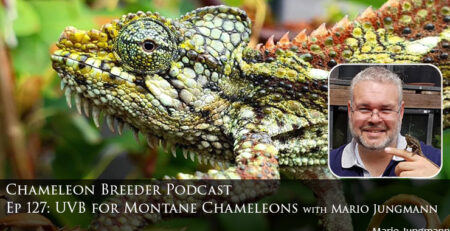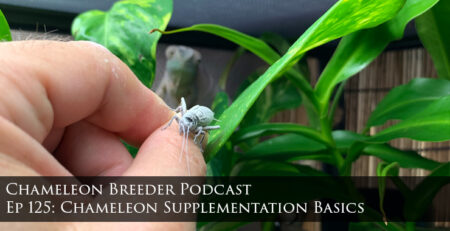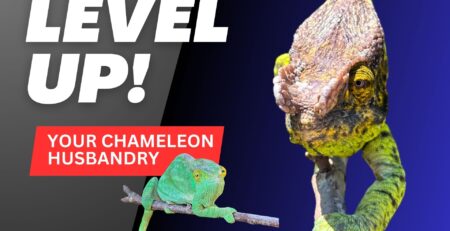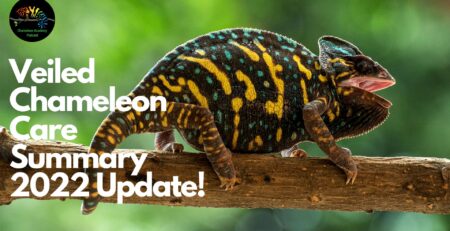Essential UVB Knowledge for Chameleons
Would you like to understand UVB for Chameleons? In this post I discuss some of the sound bites floating around social media relating to UVB and talk about what is valid and what is incorrect.
Note: This topic is discussed in the weekly Chameleon Academy Newsletter and is reviewed in both a YouTube video and a podcast episode. The video and podcast are separately produced and will provide different perspectives. Click here to join in with the weekly newsletter discussions: Chameleon Academy Newsletter sign up
Video Player
This episode is about UVB and how we use it in Veiled Chameleon husbandry. I will be mentioning panther chameleons, but there isn’t that much misinformation bouncing about regarding panther chameleons. So, it is the Veiled that we need to focus on.
In the past I have done episodes on UVB, but I get the impression it is hard to apply theory to real life and so I am going to take a different tactic today. This episode I am going to take a common piece of misinformation shared on social media and evaluate each part of it and we can apply what we are learning about UVB.
I am going to work through the often given statement in social media circles that says Panther Chameleons should be given a Reptisun 5.0/Arcadia 6% UVB bulb and a Veiled Chameleon should get a Reptisun 10.0/Arcadia 12% UVB bulb. While that statement sounds like just one of the standard opinions bouncing around social media it is a great one to work with because when we unpack it we take a look at a number of levels of misinformation stacked on top of each other. I rarely give attention to specific sound bites like this, but this one has been proven wrong for many years and the only way we can flush our community of incorrect husbandry is to educate the community members with the tools necessary to punch through the misinformation. So, let’s wipe this one off the docket so we can replace it with something accurate. To truly understand what is going on we have to start with some foundational concepts. We are going to have to learn the basics of how UVB works and relearn what we thought we knew about Veiled Chameleon natural history. And we can use this statement about Veiled Chameleons needing high UVB than panther chameleons as a structure to learn what we need to know about UVB and chameleons.

What UVB levels do Veiled Chameleons need?
Let’s start with the basis premise that Veiled Chameleons need a higher level of UVB than Panther chameleons. OR we can simplify it further – regardless of what level panther chameleons need, what levels of UVB do Veiled Chameleons need and is the Arcadia 12% T5 or Reptisun 10.0 T5 the right bulb(s) to get those levels?
Notes on UVB Bulbs used with Chameleons:
Now, before we start into this, these bulbs I am talking about are UVB bulbs. They are the leading T5 fluorescent UVB bulbs on the market. The 6% and 12% come from Arcadia and the 5.0 and 10.0 come fromZooMed. The percentage or number designations aren’t really a measurement of anything. They are marketing designations so don’t read too much into the model numbers beyond the 12% and 10.0 have higher UVB output than the 6% and 5.0. and if you wanted to go higher there is a 14% from Arcadia which is much higher. So, with that out of the way, let’s explore the idea that Veiled Chameleons need high UVB levels.
Currently, the T5 fluorescent bulb is the most used UVB source. LEDs are coming to take over so this is a bit of a dynamic situation, but we will talk T5s right now. And that is a type of fluorescent bulb. These bulb produce a spectrum of light waves that include UVB. And that is important to know because when you look at a UVB light you do see light, but remember, you cannot see UVB light. So just because you see light does not mean that UVB light is coming off the bulb. You will need a UVB meter for that. Lately we have been using the Solarmeter 6.5 which measures in units of UV Index. We used to use measurements of uw/cm^2 and you will see that in some papers on UVB.
Every UVB bulb goes through a lifecycle. They start off with extra high UVB output for about 100 hours (called the burn in time) and then plateau at their working level. During the working level the bulb slowly looses UVB output and they have to be replaced after about one years use. The output and stress the bulb is under is dependent on how often it is used, for how long, and the quality of the fixtures that drives it. So there is a wide variation in people’s experiences.
Background: How did this start?
I have the advantage that I know where this started. The idea that veiled chameleons needed high levels of UVB comes from a Facebook admin a while ago who was convinced that his Veiled Chameleons grew bigger with higher levels of UVB. He didn’t have a Solarmeter so who knows what levels he was working with, but the information bouncing around was that UVB = bigger growth. Now this is not the case at all. Yes, chameleons, like us, need UVB to synthesize vitamin D3 to allow the absorption of calcium, but the skin stops UVB production when it has enough D3 to avoid overdose of a fat soluble vitamin. More intense UVB may speed up absorption to the desired level, I do not know that one way or the other, but the skin shuts down production when it has enough. Any further exposure to UVB just works on sunburn and skin cancer. So this push for higher and higher levels of UVB for Veiled Chameleons was going in the complete wrong direction. As with much of social media, being corrected only made him use his platform to spread out further under the social media law that you can make an incorrect idea correct by getting a lot of people to repeat it. Even being corrected by an actual PhD in biology would not stop the enthusiastic spread.
And, I want to take a break, and let this sink in. The leaders of social media groups are often not chosen for their expertise. Use some other measuring stick to decide their competence. When you are corrected by a degreed expert and will not change you know there is more going on than chameleon husbandry. And this is where insisting that Veiled Chameleons need a 12% or 10.0 comes from.

Veiled Chameleon Natural History and UVB
Although the actual origin of this idea was incorrect in its logic, there actually was reason to think that, perhaps, Veileds might experience higher levels of UVB in the wild. Remember how I said we were getting these images and videos of veiled chameleons in these desolate wastelands? And Yemen is a desert, right? So the idea of Veileds being exposed to high amounts of sunlight wasn’t crazy with these scraps of information.
But this was counter acted when I found three chameleon enthusiasts that had actually been to Yemen and watched them in the wild. One of them went back for multiple trips during both the wet and dry seasons. And what we learned challenged what we thought. First, Veiled chameleons did not live in a desert. They lived in high elevation mountain valley that were dense with plants and foliage during the wet season. And during this time, Veiled Chameleon eggs would hatch and the chameleons would race to grow up before the dry season hit. When the dry season hit all the leaves would die and the Veiled Chameleons would disappear. Presumably they all died out. So, those photos of Veileds in the open are photos of Veileds on their way to dying from exposure. It turns out that the Veiled chameleons get some sun in the morning and then hide throughout the afternoon. And this also may be why we don’t see photos of them during the wet season – they are hiding away. Of course, there are always the males who will sit on top of the trees and guard their territory, but this is poor evidence that they need high UVB. The females who need the calcium the most are hiding away. The males are tolerating and fighting the UVB for territorial reasons – not for health reasons! So the reports from the wild paint a story of Veiled chameleons in this relatively small mountain oasis and hiding from the afternoon UVB.

This photo was taken by Petr Necas in Veiled Chameleon habitat in Yemen during the rainy season. We can see the lush vegetation that Chamaeleo calyptratus lives in.
You could also argue that because of the higher elevation that they may need higher UVB. We see this in some higher elevation species. Trioceros hanangensis won’t show its bright colors until it gets higher UVB. Even the Yellow crested Jackson’s Chameleon, which is actually at a lower elevation than Veiled Chameleons, seems to like a bit of a higher UVB level – though that is still being worked on. So, you could come to the conclusion that Veileds, because of their elevation, would need a higher level of UVB. The way this works is that if you are constantly hit with high levels of UVB because of being at a higher elevation, your skin develops higher resistance to UVB and higher levels are necessary to do that same job. It is just an adaptation of living at high elevations. But it is not guaranteed that is what is happening and we have to evaluate each species. So, how do we do that?

The testing of UVB and Veiled Chameleons
It is important that we test anything we think we know. And, at the time, I was hosting the Chameleon Academy Podcast. Though, at the beginning, it was called the Chameleon Breeder podcast. And the big question on my mind was, what level of UVB did our chameleons need? We had the paper that introduced the Ferguson zones which was a chart that had a wide range of reptile species and the scientists took a look at as much data from the natural condition as possible and came up with estimated UVB levels they would want. But this was a lot of extrapolation and data crunching. This was not working with actual living animals in the captive environment with the UVB producing tools that we had. There is no way they could do that with every species. So that is left to the more specialized communities. And we needed to figure that out for the chameleon community. But how do we do that? The pebble that started the avalanche was when I was talking to UK herpetoculturist Pete Hawkins who was testing out some Arcadia supplements. He tested it out on a female Veiled chameleon and the its was to see if she was healthy begin given on Arcadia EarthPro-A which had no dietary vitamin D3. She had to get it all from the UVB light. He did his test and told me about it, because we were talking about supplements. But then he mentioned the most important thing that put it all in line for me. He mentioned that she had a clutch of eggs. And I asked if they were fully calcified. They were. The reason why this was such a powerful data point was that we can measure the effectiveness of UVB levels by whether a female could lay a fully calcified clutch of eggs using those UVB levels with no dietary D3. That means that she was able to absorb enough calcium during the period of life when the demand for calcium was the greatest. Pete Hawkins was using UVI 3 at the basking branch.
So the question now was, is UVI 3 the best level? How about UVI 6? Would there be any improvement or noticeable advantage? It took me almost a year to answer this question. I had to get two pairs of Veiled chameleons. Two brothers and two sisters that were unrelated to the brothers. At least as unrelated as Veiled chameleons in captivity can be. I raised them next to each other in a garage that let in no light and one pair (separate cages, of course) got UVI 3 and one pair got UVI 6 at the basking branch. I raised them from hatchlings to adults and mated them. During this time I did not measure how long they exposed themselves to UVB, but I did monitor behavior and verified that I got no behavior cues that told me that the UVI 3 pair wanted more UVB, like hanging from the top or basking all day or that the UVI 6 pair were being hurt by the higher UVB, like going to the bottom of the cage or never coming up to bask. It was a primitive experiment, but the end result was that both females produced a clutch of eggs of around 30 eggs and both clutches were completely calcified. This told me that both UVI 3 and UVI 6 worked. But I also looked for any differences between the two pairs. I did not do regular weighings as I considered viewing their overall size and demeanor good enough for my purposes. And I found no easily discernible difference between the two pairs. What this told me was that there were no obvious benefits of going to a higher UVB level.
Now, this kind of test was a serious test. It took me almost a year to perform. But I didn’t do it at a level where I could have published the results. Looking back now I probably could have with a little more documentation, but such is life. My main reason for doing this was to show myself that UVI 3 was effective and we didn’t have to go higher than that.
So, you might ask, how does this mesh with them being high elevation? Well, different species adapt to their conditions differently. Just take the nighttime drop requirement of Jackson’s chameleons which are lower elevation than Veileds. But Veiled Chameleons will not have the same degradation in health without the night time drop and Veileds can handle higher temperatures without dying like Jackson’s will. So we can’t make blanket statements based solely on elevation. It can provide clues as to what we should look for, but it is no guarantee of what we will find.
Just to provide some context as to where things went after I did the Veiled Chameleon UVI test. Jonathan Hill of iPardalis listened to everything on the podcast and decided to replicate it with panther chameleons. He showed the panther chameleons can produce fully calcified clutches with no dietary D3 at UVI 3. In fact he did multiple generations of a test. So, panther chameleons were added to the UVI 3 group. After that, Dr. Michael Nash did a test on carpet chameleons and compared UVI 3 to UVI 7. I will let him tell you himself about his study a little later on in this episode. But the end result is that UVI 3 once again comes through as an effective basking UVI. So we are starting to see confirmation that this is a good value. It does not mean that we won’t find a better value in the future and it doesn’t mean this is the right value for every species. But you can see how there is a domino effect when people in the community take these experiments seriously. Dr. Nash’s study is a peer reviewed published study.
In closing...
The whole subject of UVB and chameleons has been a constant topic here on the Chameleon Academy. UVB is an important part of a chameleon’s husbandry. We know the most about Veiled chameleons and Panther chameleons, but there is so much more work to be done across the different species. This will be a multi-part series on UVB and lighting so we can explore different aspects of this rich topic.
Join me for a weekly discussion about chameleons
These topics are meant to be a discussion. If you would like to be part of the discussion, I introduce the topic in the Chameleon Academy newsletter which goes out every week. Each newsletter has a topic and I get feedback from the readers which I share in the subsequent newsletter and sometimes on the podcast and/or YouTube video. Yes, I share my decades of experience, but the Chameleon Academy has always been about the community and the perspective is greatly enriched when I hear from you. You can sign up for the newsletter here: Chameleon Academy Weekly Newsletter
And, with that, I think it is time for us to go out into that world and be awesome! Thank you for joining me on this journey to explore chameleon husbandry and the relationship between us and our chameleons. This is Bill Strand signing off. I will see you next time!












